Table of Contents
Introduction
According to Smart Glasses Statistics, Smart glasses are wearable devices that combine eyeglasses or sunglasses with electronic features, displaying digital information in the user’s field of vision through technologies like optical projection and OLED screens. Often associated with augmented and mixed reality, they offer features such as cameras, voice control, connectivity, sensors, and audio output.
Smart glasses find applications in enterprise, healthcare, consumer, education, and gaming sectors, with ongoing challenges including privacy concerns and design aesthetics. Future trends involve improved technology and AI integration, promising a more versatile and integrated role in our daily lives.
Editor’s Choice
- The revenue of the wearable technology market has shown a steady and consistent increase at a CAGR of 14.60% over the years, starting at $61 billion in 2022 and steadily rising to $70 billion in 2023.
- The smart glass market is poised for steady growth over the next decade, with revenues expected to rise from $5.0 billion in 2022 to an estimated $13.2 billion by 2032.
- Electro-chromic and polymer dispersed liquid crystal (PDLC) technologies each accounted for $1 billion in revenue, while suspended particle devices (SPD) and thermo-chromic technologies contributed another billion dollars collectively.
- Regarding market share, transportation stands out as a dominant force, commanding 30% of the market.
- In 2017, the unit smart glass shipments were relatively modest at 0.23 million units; however, by 2022, unit shipments skyrocketed to an impressive 32.7 million units.
- The AR glasses market is projected to experience substantial growth, with estimated unit sales of 2.11 million units in 2023 and a remarkable 3.9 million units in 2024.
- 49% of surgeons believe smart glasses can potentially decrease complications and fatalities in operating rooms, primarily resulting from human error.
Market Overview
Global Wearable Technology Market
- The revenue of the wearable technology market has shown a steady and consistent increase at a CAGR of 14.60% over the years, starting at $61 billion in 2022 and steadily rising to $70 billion in 2023.
- This growth trajectory is anticipated to continue, with projections indicating revenues of $79 billion in 2024, $94 billion in 2025, and $109 billion in 2026.
- As we move into the late 2020s, the market is expected to reach $123 billion in 2027, $134 billion in 2028, and $154 billion in 2029.
- The trend of expansion persists, with estimates of $173 billion in 2030, $199 billion in 2031, and an impressive $231 billion in 2032.
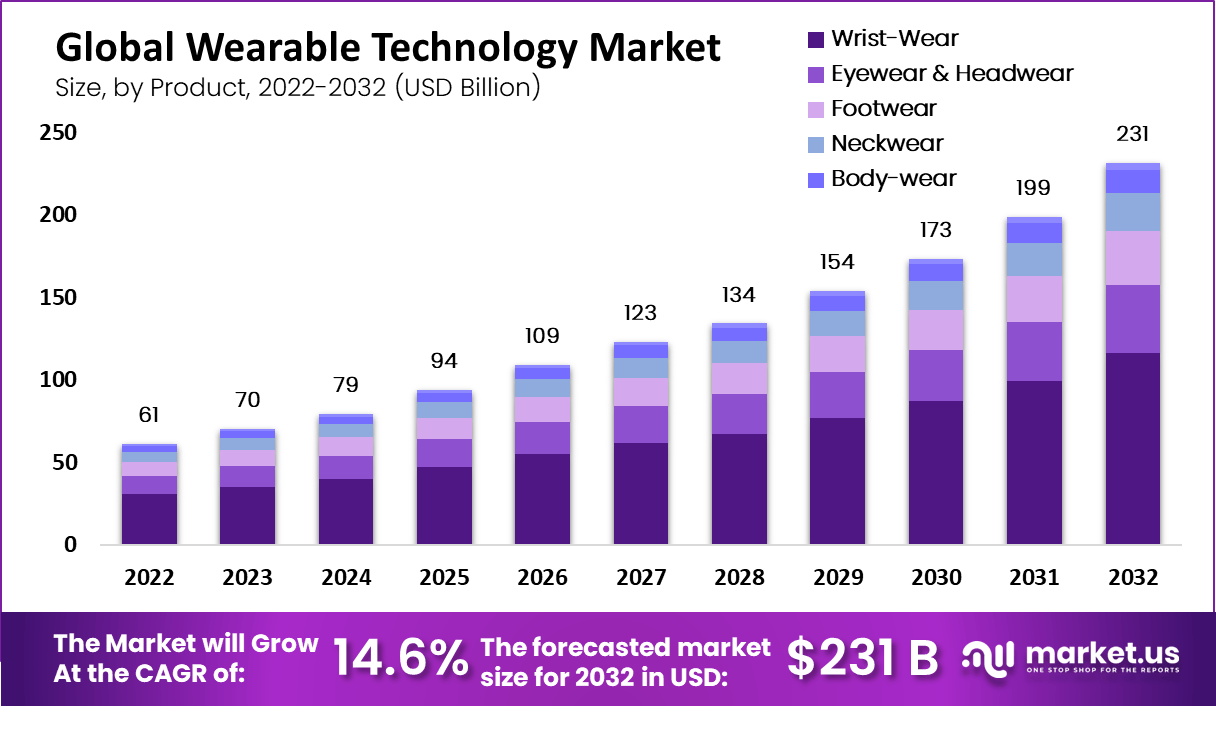
Smart Glasses Market Size and Growth
- The smart glass market is poised for steady growth over the next decade, with revenues expected to rise from $5.0 billion in 2022 to an estimated $13.2 billion by 2032.
- This impressive growth trajectory reflects the increasing adoption of smart glass technologies across various industries.
- In 2023, the market is projected to reach $5.5 billion, marking a 10% increase from the previous year.
- The growth trend continues, with revenues reaching $6.0 billion in 2024 and steadily climbing to $11.8 billion in 2031.
- By 2032, the smart glass market is anticipated to reach $231 billion, underlining the growing demand for innovative solutions that offer transparency control and energy efficiency.
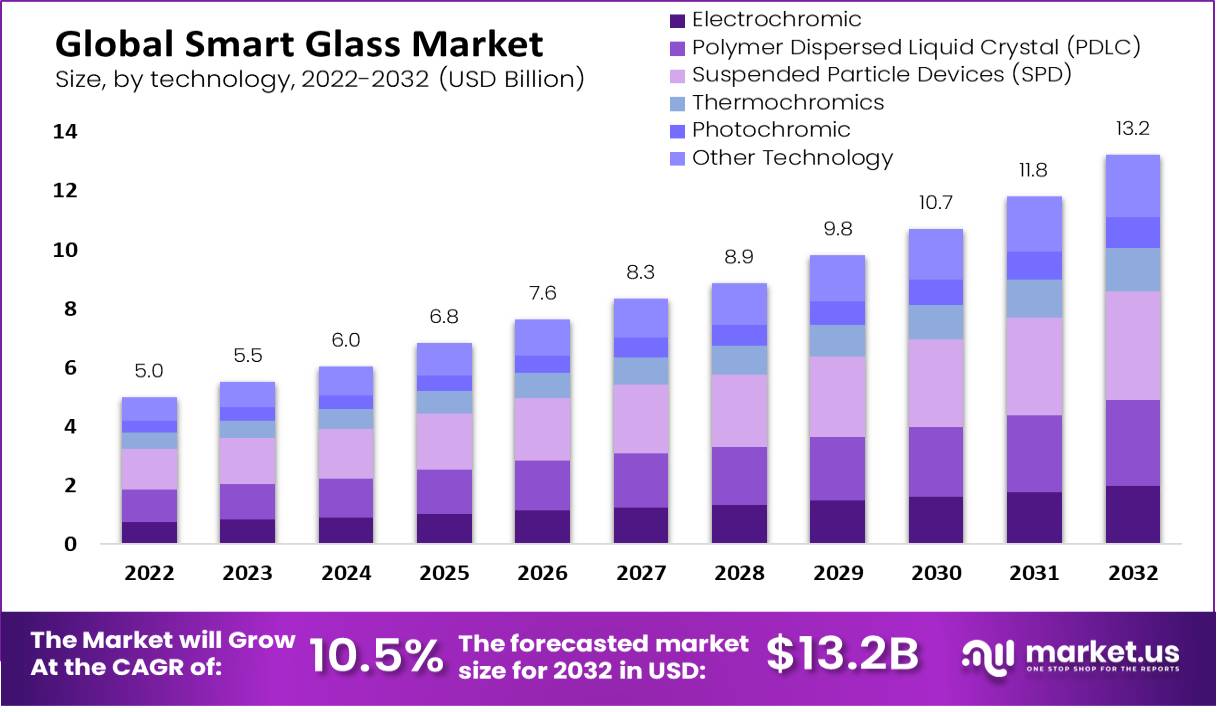
Global Smart Glass Market Revenue- By Technology
- The global smart glass market is experiencing a dynamic evolution in technology-driven revenue growth. In 2022, the market generated a total revenue of $5.0 billion, with various technologies contributing to this figure.
- Photochromic technology added a modest $0.1 billion, and there was an additional billion from other technologies.
- The smart glass market is poised for substantial expansion as we look ahead. By 2032, the total market revenue is forecasted to reach an impressive $13.2 billion. Advancements across the spectrum of smart glass technologies fuel the growth.
- Electrochromic and PDLC technologies maintain their presence, generating $3 billion in revenue by 2032. However, SPD technology stands out with $4 billion in revenue, showcasing its growing importance in the market.
- Thermochromic technology also experiences steady growth, reaching $1 billion in revenue. Photochromic technology and other emerging technologies contribute to the market with $1 billion and $2 billion in revenue, respectively.
Smart Glass Market Share- By Application
- The smart glass market exhibits a diverse distribution of market share across various applications, with each sector playing a unique role in driving its growth.
- Regarding market share, transportation stands out as a dominant force, commanding 30% of the market.
- Architectural applications closely follow, with a substantial 26% market share. The adoption of smart glass in buildings and infrastructure is on the rise, driven by the desire for energy-efficient solutions and innovative designs that offer dynamic transparency control.
- Consumer electronics comprise a significant portion of the market, holding 21% of the share.
- This reflects the growing demand for smart glass in electronic devices such as smartphones, tablets, and wearables, which are used for displays and augmented reality applications.
- Power generation applications contribute 13% to the market share, indicating the use of smart glass in solar panels and energy-efficient windows.
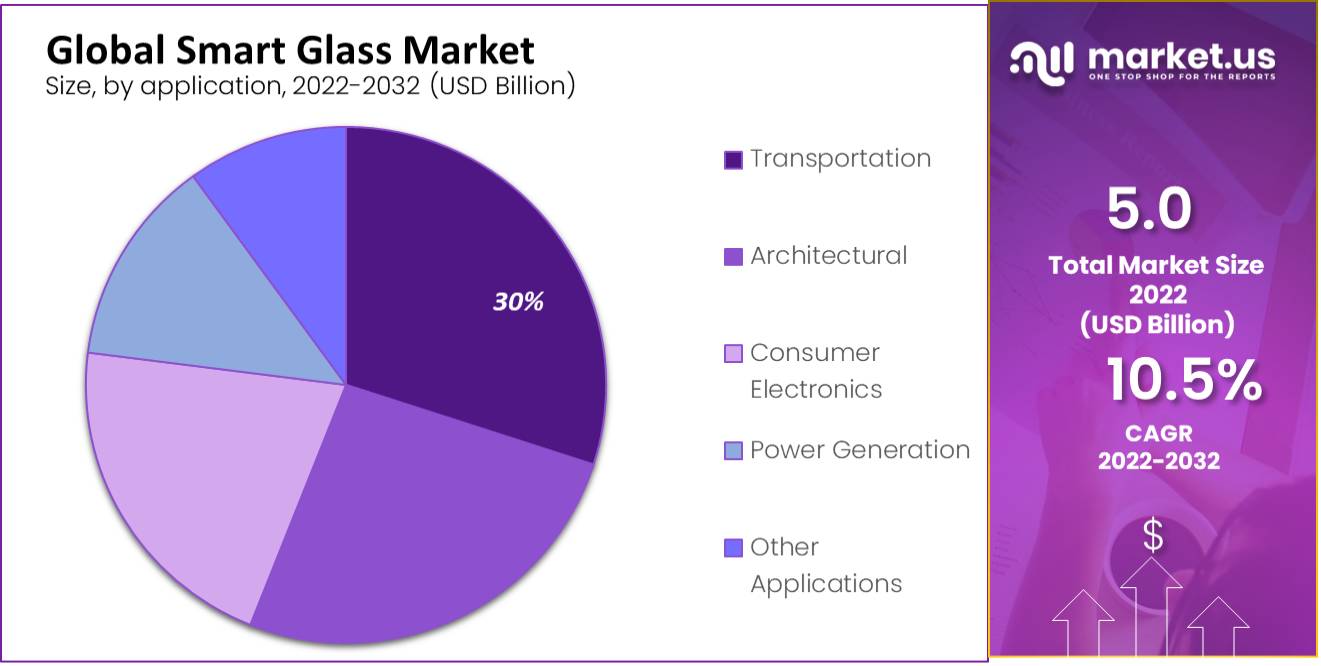
Glasses Shipments Worldwide
- The smart glasses market has seen a significant transformation in unit shipments over the years, marking a notable shift in consumer adoption.
- In 2017, the unit shipments were relatively modest at 0.23 million units, indicating limited consumer interest and market penetration.
- However, fast-forward to 2022, and the landscape has dramatically changed.
- Unit shipments skyrocketed to an impressive 32.7 million units, showcasing a substantial surge in demand and adoption of smart glasses.
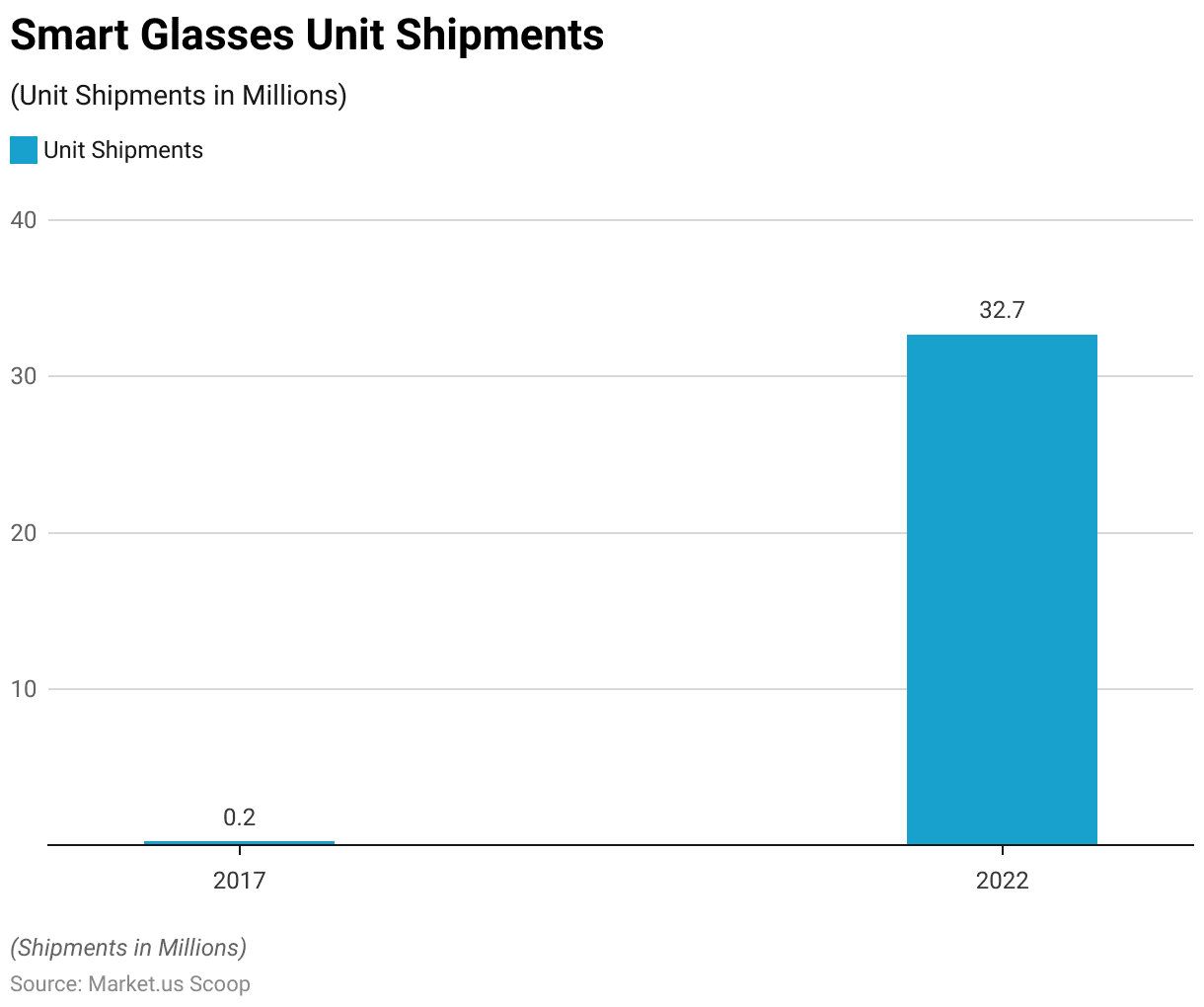
Smart Augmented Reality Glasses Statistics
Global Smart Augmented Reality Glasses Market Size
- The smart augmented reality glasses market has exhibited a remarkable growth trajectory over the past few years.
- Starting at 138.61 million dollars in 2016, the market experienced substantial expansion, with revenues surging to 19,718.88 million in 2022.
- The market witnessed significant milestones, with revenues surpassing 4.4 billion in 2018 and 15.7 billion in 2021.
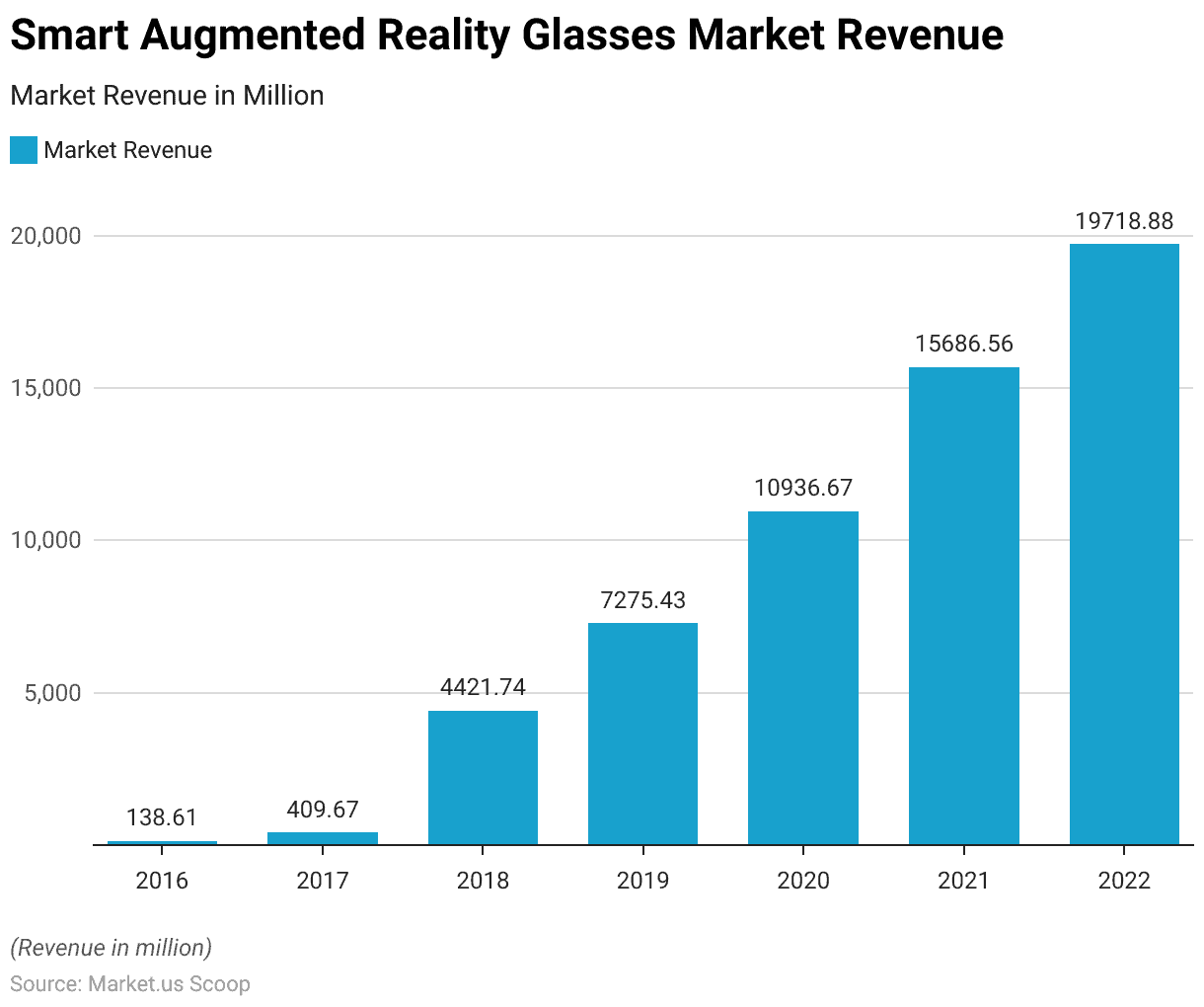
Augmented Reality (AR) Glasses Sales
- The augmented reality (AR) glasses sales have significantly increased over the years, reflecting a growing interest and adoption of this technology.
- In 2019, unit sales stood at a modest 0.17 million units, demonstrating a relatively slow start. However, by 2020, sales began to pick up, reaching 0.25 million units.
- Looking ahead, the AR glasses market is projected to experience substantial growth, with estimated unit sales of 2.11 million units in 2023 and a remarkable 3.9 million units in 2024.
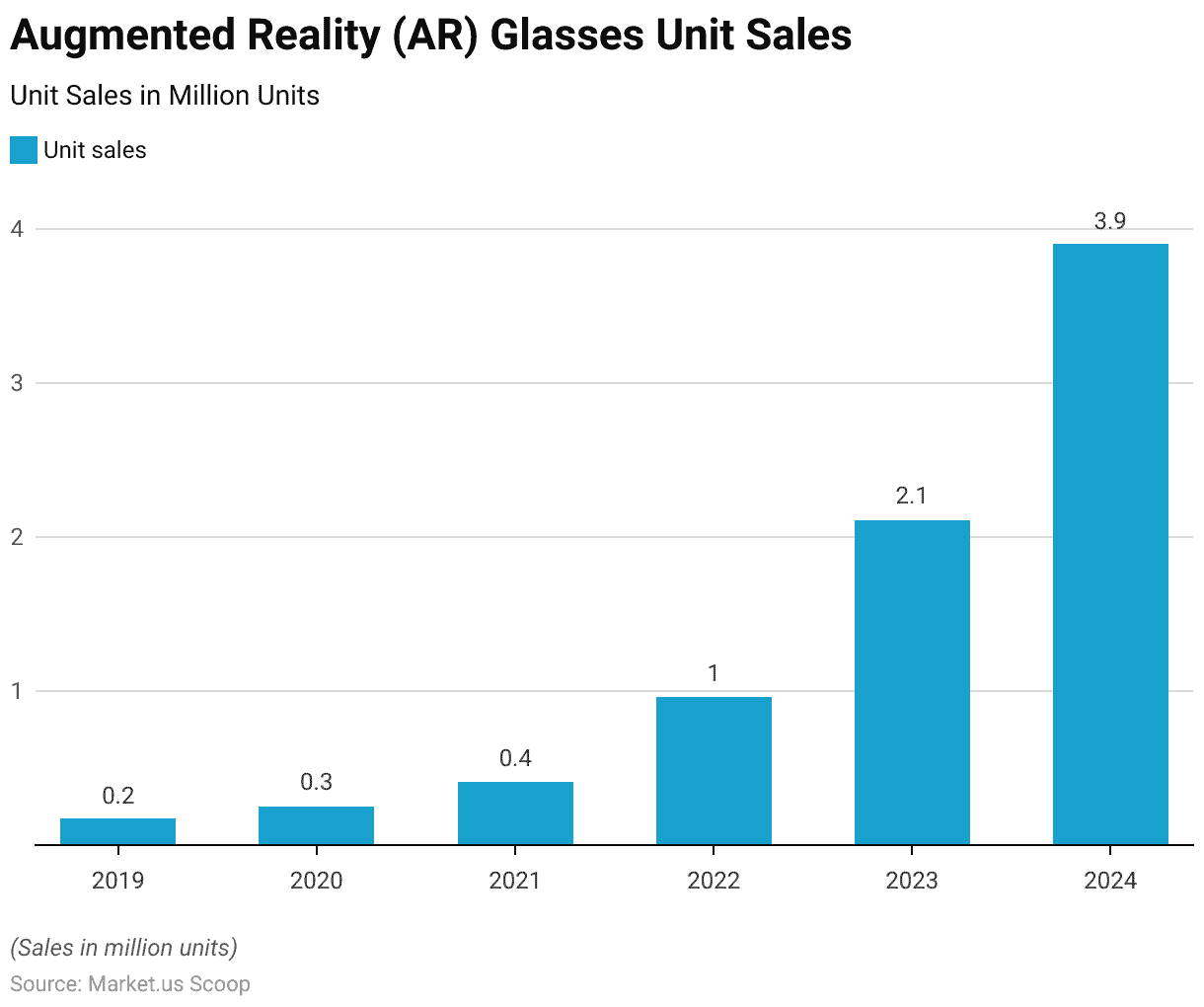
Benefits of AR Smart Glasses
- Around half of the surgeons have undergone training with AR smart glasses and acknowledge their superiority compared to traditional methods.
- Additionally, approximately 49% believe these glasses can potentially decrease complications and fatalities in operating rooms, primarily resulting from human error.
- Moreover, a significant group, comprising about 44%, has emphasized the remarkable capability of AR smart glasses to furnish essential information directly within their line of sight.
- This information includes intricate 3D anatomical images, real-time medical references, and patient data, enhancing surgical procedures.
- Furthermore, roughly 41% have recognized the potential of these smart glasses in enhancing safety within surgical environments by reducing the need for unnecessary entries and exits from the operating room.
Popular Smart Glasses
Nreal Air AR Glasses
- The Nreal Air AR Glasses come with some impressive specs. They’re incredibly lightweight, tipping the scales at just 2.79 ounces, and have 5.83 x 2.36 x 2.05 inches dimensions, making them comfortably portable.
- It’s worth noting that the battery life depends on the Nreal adapter or the phone the glasses are connected to.
- These glasses are available at a reasonable price of $379.
Razer Anzu Smart Glasses
- The Razer Anzu Smart Glasses offer a sleek and lightweight design, coming in at just 1.6 ounces with dimensions of 6.42 x 1.87 x 6.07 inches, ensuring comfort during extended wear.
- These smart glasses are priced at $200 but are currently available for a discounted price of $88 on Amazon, making them an affordable option.
- One standout feature of the Razer Anzu smart glasses is their eye-care functionality. They are equipped with blue light filtering and polarized sunglasses lenses, which help reduce eyestrain.
Rokid Air AR Glasses
- The Rokid Air AR Glasses come packed with impressive features. They’re designed to focus on convenience and portability, weighing 2.93 ounces and measuring 7.14 x 6.15 x 2.16 inches.
- Despite their compact size, they offer a compelling cinematic experience. Once you put them on, you’re immediately transported into a 120-inch cinematic world, no matter where you are.
- This immersive experience is made possible by their HD 1080p OLED display and an expansive 43-inch field of view.
Patriot ViewPoint Low Vision Glasses
- The Patriot ViewPoint Low Vision Glasses are a remarkable technology with specific specifications.
- They weigh in at 1.2 pounds and have dimensions of 7.95 x 4.58 x 3.65 inches, which positions them as a substantial yet functional wearable device.
- These glasses are priced at $2,995, and while they are not compatible with prescription lenses, they offer a unique set of features.
Ray-Ban Stories
- The Ray-Ban Stories boast an impressive blend of style and functionality. Weighing in at just 1.73 ounces, they offer a lightweight and comfortable design.
- They come in various styles, including Wayfarer in sizes 50mm and 53mm, Round at 48mm, and Meteor at 51mm, catering to various style preferences.
- Despite their regular price of $230, select styles are available on Amazon for the more budget-friendly price of $209.
Discuss your needs with our analyst
Please share your requirements with more details so our analyst can check if they can solve your problem(s)



